Related Research Articles
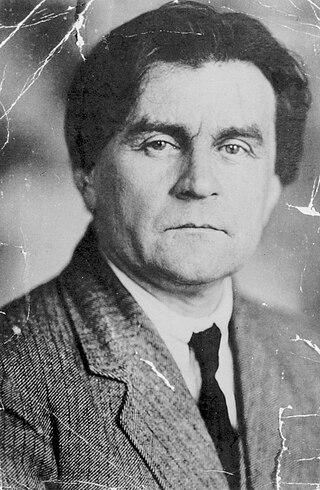
Kazimir Severinovich Malevich was a Russian avant-garde artist and art theorist, whose pioneering work and writing influenced the development of abstract art in the 20th century. He was born in Kiev, modern-day Ukraine, to an ethnic Polish family. His concept of Suprematism sought to develop a form of expression that moved as far as possible from the world of natural forms (objectivity) and subject matter in order to access "the supremacy of pure feeling" and spirituality. Active primarily in Russia, Malevich was a founder of the artists collective UNOVIS and his work has been variously associated with the Russian avant-garde and the Ukrainian avant-garde, and he was a central figure in the history of modern art in Central and Eastern Europe more broadly.

Suprematism is an early twentieth-century art movement focused on the fundamentals of geometry, painted in a limited range of colors. The term suprematism refers to an abstract art based upon "the supremacy of pure artistic feeling" rather than on visual depiction of objects.

Aleksandra Aleksandrovna Ekster, also known as Alexandra Exter, was a Russian and French painter and designer.
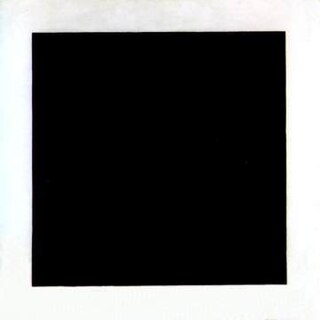
UNOVIS was a short-lived but influential group of artists, founded and led by Russian painter Kazimir Malevich at the Vitebsk Art School in 1919.

The Russian avant-garde was a large, influential wave of avant-garde modern art that flourished in the Russian Empire and the Soviet Union, approximately from 1890 to 1930—although some have placed its beginning as early as 1850 and its end as late as 1960. The term covers many separate, but inextricably related, art movements that flourished at the time; including Suprematism, Constructivism, Russian Futurism, Cubo-Futurism, Zaum, Imaginism, and Neo-primitivism. In Ukraine, many of the artists who were born, grew up or were active in what is now Belarus and Ukraine, are also classified in the Ukrainian avant-garde.

Olga Vladimirovna Rozanova was a Russian avant-garde artist painting in the styles of Suprematism, Neo-Primitivism, and Cubo-Futurism.
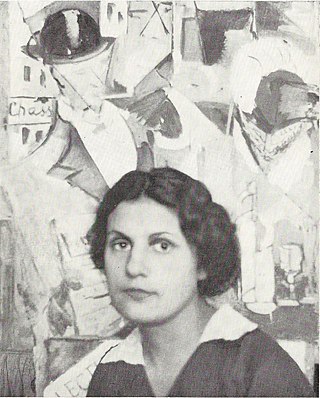
Nadezhda Andreevna Udaltsova was a Russian avant-garde artist, painter and teacher.

Nathan Isaevich Altman Russian: Натан Исаевич Альтман, romanized: Natan Isayevich Altman; Ukrainian: Натан Ісайович Альтман; 22 December [O.S. 10 December] 1889 – 12 December 1970) was a Russian avant-garde artist, Cubist painter, stage designer and book illustrator, who was born in Ukraine in the Russian Empire and worked in France and the Soviet Union.
Nikolai Suetin was a Russian Suprematist artist. He worked as a graphic artist, a designer, and a ceramics painter.
George Costakis was a Greek-Russian art collector who amassed one of the largest private collections of Russian avant-garde art in the world.

El Lissitzky, was a Soviet Jewish artist, active as a painter, illustrator, designer, printmaker, photographer, and architect. He was an important figure of the Russian avant-garde, helping develop suprematism with his mentor, Kazimir Malevich, and designing numerous exhibition displays and propaganda works for the Soviet Union.
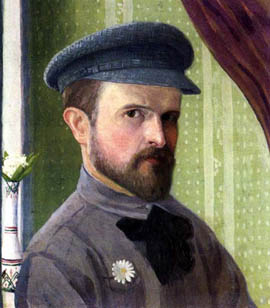
Ivan Vasilievich Kliun, or Klyun, born Klyunkov was a Russian Avant-Garde painter, sculptor and art theorist, associated with the Suprematist movement.

Ilya Grigorevich Chashnik was a suprematist artist, a pupil of Kazimir Malevich and a founding member of the UNOVIS school.

Suprematist Composition: White on White (1918) is an abstract oil-on-canvas painting by Kazimir Malevich. It is one of the more well-known examples of the Russian Suprematism movement, painted the year after the October Revolution.

Painterly Realism of a Peasant Woman in Two Dimensions, also known as Red Square, is a 1915 painting by Kazimir Malevich. Red Square was part of Malevich's Suprematist art movement (1915-1919), which aimed to create artworks that were universally understood.
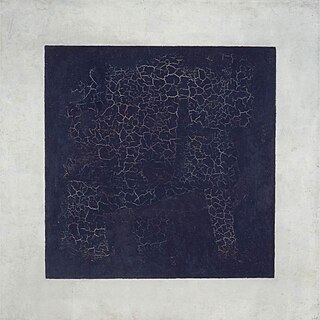
Black Square is a 1915 oil on linen canvas painting by the Russian avant-garde artist and theorist Kazimir Malevich. There are four painted versions, the first of which was completed in 1915 and described by the artist as his breakthrough work and the inception of his Suprematist art movement (1915–1919).

Lazar Markovich Khidekel was an artist, designer, architect and theoretician, who is noted for realizing the abstract, avant-garde Suprematist movement through architecture.
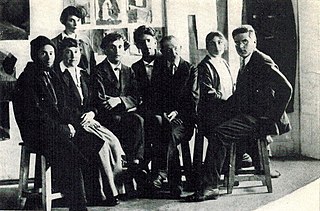
Vera Ermolaeva was a Russian painter, graphic artist and illustrator who participated in the Russian avant-garde movement.

Nina Kogan was a Russian painter known for her Suprematist works.
Anna Aleksandrovna Leporskaya was a Soviet avant-garde artist. She was a recipient of several awards, including Honored Artist of the RSFSR and the Repin State Prize.
References
- ↑ Rakitin, Vasily. (2013) "Anna Kagan" in Rakitin, Vasily and Sarabianov, Andrei eds. Encyclopedia of the Russian Avant-Garde, Volume 1 (in Russian). Moscow: RA. p. 400.
- 1 2 3 Gimpelevich, Zina (2023-02-06). Biełarusian Fine Art: Time and Time Again: Origin, History, Discourse, and Biographies. FriesenPress. pp. 84–85. ISBN 978-1-0391-5878-8.
- 1 2 "Ontdek graficus, ontwerper, schilder Anna Aleksandrovna Kagan". rkd.nl.
- ↑ Shatskikh, Aleksandra Semenovna (2007-01-01). Vitebsk: The Life of Art. Yale University Press. p. 131. ISBN 978-0-300-10108-9.
- ↑ "Black Square: In the Circle of Malevich and UNOVIS Group". Howard Schickler Fine Art. Archived from the original on 11 March 2005. Retrieved 7 January 2025.
- ↑ Konstantin, Akinsha (1 July 2009). "The Faking of the Russian Avant-Garde". Artnews.
- ↑ "Anna Kogan". FAMSF Search the Collections. September 21, 2018.
- ↑ "Suprematist Composition". Seattle Art Museum. Retrieved 7 January 2025.